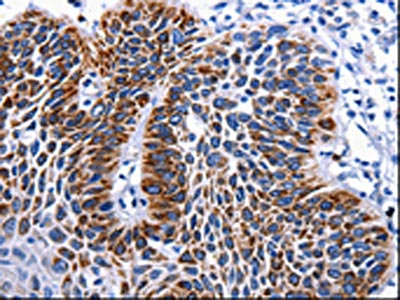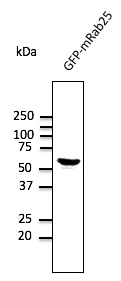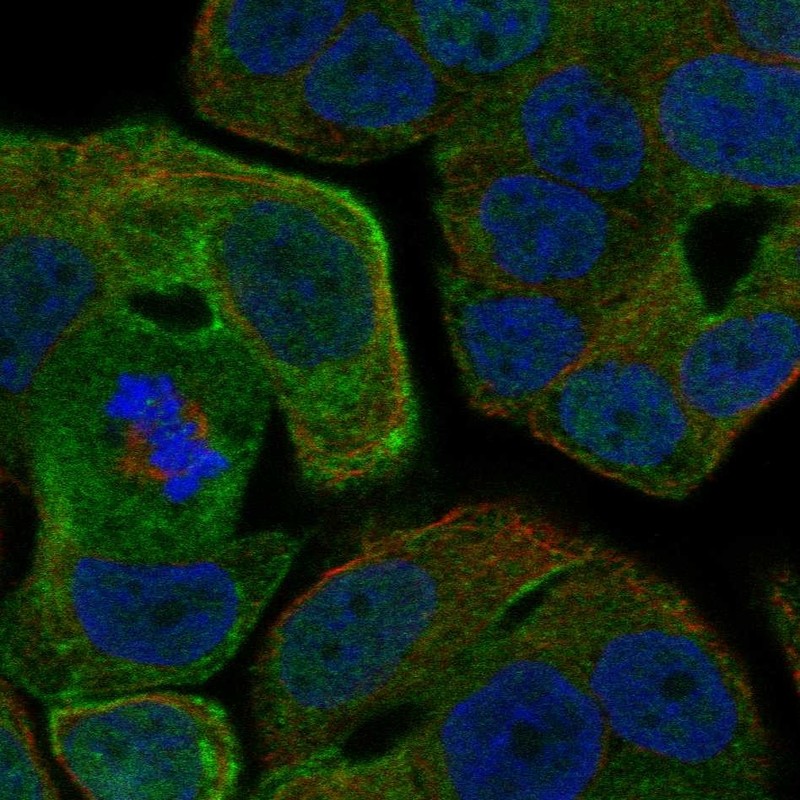![FACS analysis of NIH3T3 cells using GTX82785 Rab25 antibody [3F12]. Green : Rab25 Purple : negative control FACS analysis of NIH3T3 cells using GTX82785 Rab25 antibody [3F12]. Green : Rab25 Purple : negative control](https://www.genetex.com/upload/website/prouct_img/normal/GTX82785/GTX82785_20170912_FACS_w_23061322_713.webp)
FACS analysis of NIH3T3 cells using GTX82785 Rab25 antibody [3F12]. Green : Rab25 Purple : negative control
Rab25 antibody [3F12]
GTX82785
ApplicationsFlow Cytometry, ImmunoFluorescence, Western Blot, ELISA, ImmunoCytoChemistry, ImmunoHistoChemistry, ImmunoHistoChemistry Paraffin
Product group Antibodies
TargetRAB25
Overview
- SupplierGeneTex
- Product NameRab25 antibody [3F12]
- Delivery Days Customer9
- Application Supplier NoteWB: 1/500 - 1/2000. ICC/IF: 1/200 - 1/1000. IHC-P: 1/200 - 1/1000. FACS: 1/200 - 1/400. ELISA: 1/10000. *Optimal dilutions/concentrations should be determined by the researcher.Not tested in other applications.
- ApplicationsFlow Cytometry, ImmunoFluorescence, Western Blot, ELISA, ImmunoCytoChemistry, ImmunoHistoChemistry, ImmunoHistoChemistry Paraffin
- CertificationResearch Use Only
- ClonalityMonoclonal
- Clone ID3F12
- ConjugateUnconjugated
- Gene ID57111
- Target nameRAB25
- Target descriptionRAB25, member RAS oncogene family
- Target synonymsCATX-8, RAB11C, ras-related protein Rab-25
- HostMouse
- IsotypeIgG1
- Protein IDP57735
- Protein NameRas-related protein Rab-25
- Scientific DescriptionRAB proteins, such as RAB25, are members of the RAS superfamily of small GTPases that are involved in membrane trafficking. Members of the RAB11 subfamily, including RAB25, control the return of internalized membrane-associated moieties to the cell surface (Caswell et al., 2007 [PubMed 17925226]).[supplied by OMIM, Aug 2009]
- Storage Instruction-20°C or -80°C,2°C to 8°C
- UNSPSC12352203
References
- Qiu S, Xu H, Lin Z, et al. The blockade of lipophagy pathway is necessary for docosahexaenoic acid to regulate lipid droplet turnover in hepatic stellate cells. Biomed Pharmacother. 2019,109:1841-1850. doi: 10.1016/j.biopha.2018.11.035Read this paper

![ICC/IF analysis of A549 cells using GTX82785 Rab25 antibody [3F12]. Green : Rab25 Blue: DRAQ5 fluorescent DNA dye Red: Actin filaments ICC/IF analysis of A549 cells using GTX82785 Rab25 antibody [3F12]. Green : Rab25 Blue: DRAQ5 fluorescent DNA dye Red: Actin filaments](https://www.genetex.com/upload/website/prouct_img/normal/GTX82785/GTX82785_20170912_ICCIF_w_23061322_182.webp)
![IHC-P analysis of esophagus tissue (left) and human lung cancer (right) using GTX82785 Rab25 antibody [3F12]. IHC-P analysis of esophagus tissue (left) and human lung cancer (right) using GTX82785 Rab25 antibody [3F12].](https://www.genetex.com/upload/website/prouct_img/normal/GTX82785/GTX82785_20170912_IHC-P_w_23061322_305.webp)
![WB analysis of MCF-7 (1), T47D (2) and GC7901 (3) cell lysate using GTX82785 Rab25 antibody [3F12]. WB analysis of MCF-7 (1), T47D (2) and GC7901 (3) cell lysate using GTX82785 Rab25 antibody [3F12].](https://www.genetex.com/upload/website/prouct_img/normal/GTX82785/GTX82785_20170912_WB_w_23061322_378.webp)

![IHC-P analysis of human bladder carcinoma (A), breast carcinoma (B), esophagus carcinoma (C), skin carcinoma (D) tissu using GTX83350 Rab25 antibody [3F12F3].](https://www.genetex.com/upload/website/prouct_img/normal/GTX83350/GTX83350_20170912_IHC-P_w_23061322_972.webp)




